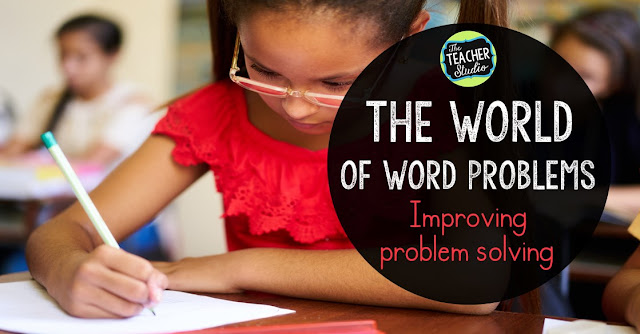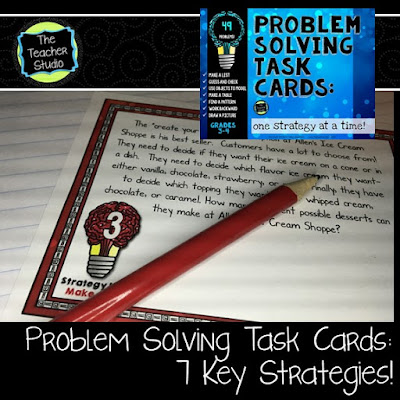







Here we go! On to challenge 3 with a focus on word problems and problem-solving. If you are just joining us, I have linked to all the other posts related to this summer math challenge at the bottom so check them all out1
Today’s challenge is all about reflecting on problem-solving–how we teach it AND how we make it accessible to students. I am hoping something in this post resonates with you–and if it does, please consider dropping into the Facebook group and sharing your thoughts!
First of all, I want to go on record as saying that I think it’s crucial that we, as teachers, understand that teaching the act of “solving problems” is very different than using word problems to practice already taught skills. My point is this. We can give students word problems that ask them to multiply. Or compare fractions. Or add money. But the act of TEACHING students how to solve problems is another entity altogether. They are both important–but we need to be mindful of what we are working on when we select our problems.
Secondly, we often use the term “problem solving” and “word problems” as if they mean the same thing. Students can be provided MANY situations where problem-solving is required–but are not word problems. More on THAT later! Today’s post is about incorporating more word problems or “story problem” into your day. As we know, making math meaningful with real world applications is critical. Word problems can be a great way for students to see how math ties to the real world–as long as we find good problems!
Teaching Problem Solving Strategies
First of all, I think it is really important to give students problem-solving “tools” in their toolbox. So often our textbooks teach one strategy in each chapter…so they might have to wait until chapter 9 to learn that they can draw a picture to solve a problem! I’m not a fan of that approach and prefer a problem solving “boot camp” at the start of the year to get students thinking about and using different strategies.
That way, as different problems come up throughout the year, they can draw from this foundation. Knowing how to work backward, draw a picture, make a table–these are all so important not just on the one page of the math textbook, but for the rest of their mathematical lives! Although I won’t go into this in detail in this post, these strategies are integrally tied to the Standards for Mathematical Practice and other rigorous math “behavior” standards.
How Do I Do It?
The image below is the set of task cards I use at the beginning of the year to teach 7 different strategies. I explicitly teach each one–then the last set of cards asks students to apply what they have learned and select an appropriate strategy. It’s also available in a digital format. Just click the image or HERE if you are interested.
Word Problems As Problem-Solving Warm Ups
I do this in a few different ways…see if any seem like they could work for you!
- Try projecting one problem on the board and students first talk about it, then solve independently, then share solutions and thinking.
- Each student gets a copy of the problem to glue into their math notebook. They work to solve independently, then share in pairs or bring it back to the whole class for a discussion.
- Provide a problem (maybe a task card, maybe projected) where a small group first discusses strategies that would work (no paper and pencil!) and then students go back to try it on their own.
- Students work to solve a problem on their own and then different students share their strategies with the class or under a document camera. This can also be a great time for students who organized their work really well to showcase that!
- Solve a problem as a whole class and then send students off to try writing a similar problem.
- Use a problem that has blanks instead of numbers and then give three choices of numbers to use…students can pick their level of challenge
- And so many more!
Word Problems on Display
Another great way to incorporate more problem solving is simply to have tons of problems available at all times! Problem-solving is ALWAYS an option if students have extra time in my class…never is there a “What should we do?” because no matter what, there are ALWAYS problems around! You can even find ways to differentiate. For example, you can print on different colors, put problems in different colored pocket charts, or label bins with different levels of challenge. This is a perfect way to help students do a little self-assessing about their readiness for different tasks. If they have a true growth mindset, it is fun to watch them push themselves toward more rigorous problems!
Cooperative Word Problems and Problem Solving in a Math Workshop
One of the many “truths” about teaching as that no two students are ever in exactly the same place. There are times when working on the same problem is meaningful, but there are other times that we need to be mindful of these differing abilities. Here are few nuggets to ponder.
Ways to Differentiate and Scaffold Word Problems and Problem-Solving
- Sometimes students can tackle the same problem if you make “tools” available to them. If you are truly working on the problem-solving process and not a skill (like subtraction), why not make manipulatives or calculators available? That way students who don’t have the math computation skill can still work to understand the problem itself and work to solve it.
- One of my FAVORITES (and this is why so many of the word problems I write do this) is to have problems that have a “part 2”. I simply add a “challenge” component for students who easily manage the first part. This puts students on equal footing for the first part. It also allows those who are ready to move on to the next part. This also would allow you time to meet with those who need help on the first part while the others tackle the second part.
- Work in pairs! This is a great way to make problems more accessible to students.
- Do a “presolve” meeting with anyone who is interested. What I mean by this is…invite (or require!) students who need a quick discussion or read-through of the problem to meet with you first so you can get them off on the right foot. Don’t give everything away! Read through the problem with them, ask them what they notice, maybe even ask them to share out what strategies might get them started. After this, THEN send them on their way.
- Put “hints” up someplace in the room. A simple piece of folded paper taped to the board with a hint inside can free students up who get stuck beyond “unsticking” without needing teacher help. Even a series of hints can be useful!
- Have students offer to be problem coaches for the day…people other students can go to for ideas and hints. You WILL have to teach students how to give hints rather than do the work for them…and sometimes teaching students to ask questions is the best way to do that. It works for you too–teachers often give away too much to students. Try asking questions like, “What do you know already?” or “What have you tried?” or “What is confusing you?” instead of SHOWING them the next step.
- Have your problems around the room categorized–maybe a green pocket chart for “go ahead” and try for easier problems and a yellow chart for “slow down” before you choose? Color-coded envelopes or bins? Or check out THIS POST for some other ideas.
- Use problems that have different number choices (see above)
Teaching Fractions? Then Why Are They Solving a Money Problem?
“Well, we have been working on multiplying all week, so this must be a multiplication story.”
Your Role. Your Students’ Role.
One thing I think is important to reflect on are the “verbs” we associate with teaching and learning with problem-solving. Do we observe? Coach? Question? Guide? Listen? Watch?I think so often we don’t. We rush. Tell. Help. Do.
And what about the students? Do they think? Listen? Watch? Try? Adjust? Or do they wait? Freeze? Ask? Quit?
One great thing to do is to lay out some of these verbs for ourselves–and our students. Making an anchor chart of “my job” and “your job” is a great way to help craft that culture of math investigation and mindset. Give it a try–see what you and your students can come up with!
A Problem-Solving Freebie for You!
One shared responsibility teachers and students DO need to have is assessment and self-monitoring (more on this in an upcoming challenge!) but since we are on the subject of problem-solving, I thought I’d link to a problem solving rubric freebie if you are interested in trying one version of a rubric. It might help you and your students get on the same page for the complex world of problem-solving. Or it might inspire you to write one together!
Click HERE for Challenge 2 (math talk and mindset)
Or HERE for Challenge 3 (word problems and problem solving)
Click HERE for Challenge 4 (math organization)
Or HERE for Challenge 5 (math assessment)
Click HERE for Challenge 6 (meaningful problem solving)









